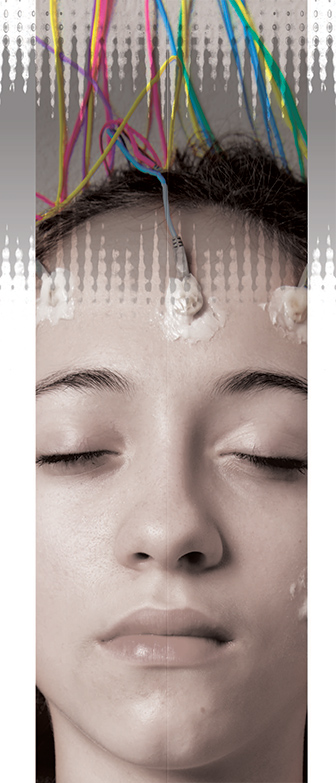Neurofeedback Treatment for ADHD
L. Eugene Arnold MD, MEd
Attention Magazine February 2019
Download PDF
NEUROFEEDBACK is a painless way for people to get information about the electrical activity in their brains and change it. Electrical activity is how brain cells send signals.
When someone undergoes neurofeedback, sensors are placed on their head to measure electrical activity, which shows up as "brain waves" on a screen. The waves can be seen on the screen in bands of different frequencies. Each band has a certain amount of voltage (power) at a given point in time.
The idea of the treatment is to engage in mental exercises to alter the brain waves. The person will be given a goal to do entirely with their brain, such as making something in the video game move, which they will be able to do when their brain waves are at the right frequency. Over time, repeating such mental tasks can change the patterns of the brain waves similar to an athlete training muscles by practice.
Neurofeedback treatment will usually need to be repeated many times–usually twenty to forty sessions–for optimal results.

How could neurofeedback help a person who has ADHD?
There are four kinds of waves that can be measured:
● Delta waves (1-4 per second) are the main waves during sleep.
● Theta waves (4-8 per second) are the main waves when a person is feeling drowsy and having trouble paying attention.
● Alpha waves (9-12 per second) are the main waves when a person is alert and awake but not focusing on anything.
● Beta waves (more than 12 per second) are the waves when someone is engaged in a task that requires problem solving, thinking, or planning.
Most people with ADHD have too much power in their theta waves and not enough in their beta waves. That means they have a hard time paying attention and don't do well with planning and organization or problem solving–the classic signs of ADHD. Recognizing this pattern in the brain waves helped researchers suspect that it could be useful to decrease theta power while increasing beta power. Thus training theta down and beta up is the most common form of neurofeedback for ADHD.
Does it work and should I sign up?
Many studies on neurofeedback and ADHD have been done, but their results have been inconsistent, with some supporting neurofeedback as a treatment and others saying it doesn't work well enough. Part of the problem may be in the studies themselves, some of which were quite small or were not conducted with the greatest scientific accuracy.
Overall, neurofeedback looks promising, but most researchers agree they would like to see more proof that it works before recommending it regularly for people with ADHD. For example, a meta-analysis (overall analysis of all known studies) found a very small, although significant, advantage of neurofeedback over control groups. One good thing is that any benefits may last for up to a year after treatment and even increase after the end of treatment. That is much longer than ADHD medication, which only works while taken.
What are the downsides?
There are some possible risks to neurofeedback, including headaches, a reaction to medication after treatment, or an increase in anxiety levels, especially if someone is given training that isn't appropriate to their brain wave patterns. Since it's an expensive treatment in both money and time, and many insurance plans don't cover it, it's not practical for a lot of people.
In addition, because ADHD can have different causes, neurofeedback is not a one-size-fits-all solution. It is not clear whether people with different patterns of brain waves could be better helped by other treatments.
Be aware that "packaged" neurofeedback systems for home use have not been proven and are considered inadequate by experts. The most successful neurofeedback involves one-on-one visits to an experienced professional. But not everyone who advertises neurofeedback is adequately trained to provide it, even in clinics. At the very least, a reputable neurofeedback provider should be certified by the Biofeedback Certification International Alliance (BCIA) and have some mentored experience.
If no progress is seen with twenty treatments, it's not likely to work for that individual. Maximum benefit is usually attained by thirty-five or forty treatments, so additional treatments beyond forty are generally not useful. At the current state of knowledge, a family should not make extreme sacrifices to obtain neurofeedback.
L. Eugene Arnold, MD, MEd, is professor emeritus of psychiatry and behavioral health at the Nisonger Center at Ohio State University's Wexner Medical Center. Dr. Arnold's research focuses on new drug development and alternative and complementary treatments for autism and ADHD. His research includes aromatic essential oil therapy for autism spectrum disorder, omega-3 fatty acids for mood disorders, neurofeedback for ADHD, nutrition and mental health, and clinical trials. A former member of CHADD's professional advisory board, Dr. Arnold currently serves as the resident expert for the National Resource Center on ADHD.
Other Articles in this Edition
Mindfulness, Meditation, and Yoga as Treatments for ADHD
Celebrating Emerging ADHD Researchers
The Challenging Horizons Program and School Success
ADHD and Life Expectancy: Treatment Matters More Than You Might Think
Health Outcomes of ADHD: Is There an Effect on Life Expectancy?
Children and Violent Behavior: Where it Comes From and What to Do
Managing Inattentive ADHD with Psychosocial Treatments
Homework: Do You Take More Responsibility Than Your Child Does?
Summer Camps: Like Horses for Courses
Frenzied, Frazzled, and Overwhelmed: The Interaction of Hormones and ADHD in Women in Midlife
